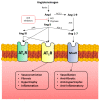Angiotensin-Converting Enzyme 2 Expression and Severity of SARS-CoV-2 Infection
- PMID: 36985188
- PMCID: PMC10054549
- DOI: 10.3390/microorganisms11030612
Angiotensin-Converting Enzyme 2 Expression and Severity of SARS-CoV-2 Infection
Abstract
Angiotensin-converting enzyme 2 (ACE2), first discovered in 2000, serves as an important counterregulatory enzyme to the angiotensin II-mediated vasoconstrictive, pro-inflammatory, and pro-fibrotic actions of the renin-angiotensin system (RAS). Conversion of angiotensin II to the peptide angiotensin 1-7 (ANG 1-7) exerts protective vasodilatory, anti-inflammatory, and anti-fibrotic actions through interaction with the MasR receptor. There are many important considerations when noting the role of ACE2 in the pathogenesis and sequelae of COVID-19 infection. ACE2, in the role of COVID-19 infection, was recognized early in 2020 at the beginning of the pandemic as a cell membrane-bound and soluble binding site for the viral spike protein facilitating entering into tissue cells expressing ACE2, such as the lungs, heart, gut, and kidneys. Mechanisms exist that alter the magnitude of circulating and membrane-bound ACE2 (e.g., SARS-CoV-2 infection, viral variants, patient characteristics, chronic disease states, and the degree of cell surface expression of ACE2) and the influence these mechanisms have on the severity of disease and associated complications (e.g., respiratory failure, systemic inflammatory response syndrome, acute myocarditis, acute kidney injury). Several medications alter the ACE2 receptor expression, but whether these medications can influence the course of the disease and improve outcomes is unclear. In this review, we will discuss what is known about the interrelation of SARS-CoV-2, ACE2 and the factors that may contribute to the variability of its expression and potential contributors to the severity of COVID-19 infection.
Keywords: COVID-19; SARS-CoV-2; angiotensin-converting enzyme 2.
Conflict of interest statement
The authors declare no conflict of interest.
Figures

Similar articles
-
Testing the efficacy and safety of BIO101, for the prevention of respiratory deterioration, in patients with COVID-19 pneumonia (COVA study): a structured summary of a study protocol for a randomised controlled trial.Trials. 2021 Jan 11;22(1):42. doi: 10.1186/s13063-020-04998-5. Trials. 2021. PMID: 33430924 Free PMC article.
-
Insights on SARS-CoV-2 Molecular Interactions With the Renin-Angiotensin System.Front Cell Dev Biol. 2020 Sep 16;8:559841. doi: 10.3389/fcell.2020.559841. eCollection 2020. Front Cell Dev Biol. 2020. PMID: 33042994 Free PMC article. Review.
-
Repressed Ang 1-7 in COVID-19 Is Inversely Associated with Inflammation and Coagulation.mSphere. 2022 Aug 31;7(4):e0022022. doi: 10.1128/msphere.00220-22. Epub 2022 Aug 1. mSphere. 2022. PMID: 35913134 Free PMC article.
-
A pressor dose of angiotensin II has no influence on the angiotensin-converting enzyme 2 and other molecules associated with SARS-CoV-2 infection in mice.FASEB J. 2021 Mar;35(3):e21419. doi: 10.1096/fj.202100016R. FASEB J. 2021. PMID: 33566370 Free PMC article.
-
Circulating angiotensin converting enzyme 2 and COVID-19.World J Clin Cases. 2022 Dec 6;10(34):12470-12483. doi: 10.12998/wjcc.v10.i34.12470. World J Clin Cases. 2022. PMID: 36579082 Free PMC article. Review.
Cited by
-
Farnesoid X receptor enhances epithelial ACE2 expression and inhibits virally induced IL-6 secretion: implications for intestinal symptoms of SARS-CoV-2.Am J Physiol Gastrointest Liver Physiol. 2023 Nov 1;325(5):G446-G452. doi: 10.1152/ajpgi.00099.2023. Epub 2023 Sep 12. Am J Physiol Gastrointest Liver Physiol. 2023. PMID: 37697930 Free PMC article.
-
A Literature Review on the Relative Diagnostic Accuracy of Chest CT Scans versus RT-PCR Testing for COVID-19 Diagnosis.Tomography. 2024 Jun 14;10(6):935-948. doi: 10.3390/tomography10060071. Tomography. 2024. PMID: 38921948 Free PMC article. Review.
-
Inclusion of deuterated glycopeptides provides increased sequence coverage in hydrogen/deuterium exchange mass spectrometry analysis of SARS-CoV-2 spike glycoprotein.Rapid Commun Mass Spectrom. 2024 Mar 15;38(5):e9690. doi: 10.1002/rcm.9690. Rapid Commun Mass Spectrom. 2024. PMID: 38355883 Free PMC article.
-
Association of Renin-Angiotensin Pathway Gene Polymorphisms with COVID-19 Susceptibility and Severity in Moroccans: A Case-Control Study.Biochem Genet. 2025 Jun;63(3):2225-2243. doi: 10.1007/s10528-024-10813-6. Epub 2024 May 8. Biochem Genet. 2025. PMID: 38717614
-
ACE2 and TMPRSS2 expression in patients before, during, and after SARS-CoV-2 infection.Front Cell Infect Microbiol. 2024 Mar 28;14:1355809. doi: 10.3389/fcimb.2024.1355809. eCollection 2024. Front Cell Infect Microbiol. 2024. PMID: 38606293 Free PMC article.
References
-
- Hoffmann M., Kleine-Weber H., Schroeder S., Krüger N., Herrler T., Erichsen S., Schiergens T.S., Herrler G., Wu N.-H., Nitsche A., et al. SARS-CoV-2 Cell Entry Depends on ACE2 and TMPRSS2 and Is Blocked by a Clinically Proven Protease Inhibitor. Cell. 2020;181:271–280.e8. doi: 10.1016/j.cell.2020.02.052. - DOI - PMC - PubMed
Publication types
LinkOut - more resources
Full Text Sources
Miscellaneous

